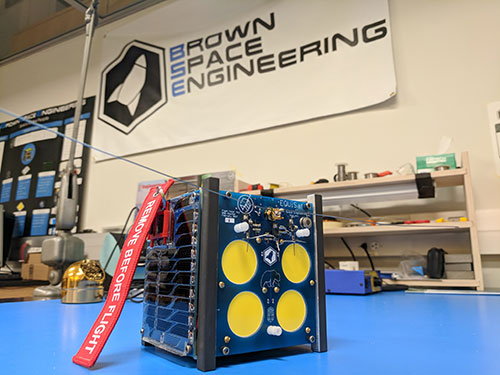PROVIDENCE, R.I. [Brown University] — A small satellite designed and built by Brown students is now just a few days away from its trip to space.
The satellite, dubbed EQUiSat, will fly aboard an Antares rocket and Cygnus cargo spacecraft to the International Space Station, where astronauts will deploy it into orbit sometime in June. The launch is scheduled for Sunday, May 20, at 5:04 a.m EDT from NASA’s Wallops Island Flight Facility. The launch will be streamed live on the web. [UPDATE: NASA announced on Friday that the launch has been bumped to Monday, May 21, at 4:39 a.m. EDT.]
The launch marks a moment that has been awaited anxiously by more than 100 current and former Brown students who have worked on the project over the past seven years. Around 30 students and alumni will make the trip to Wallops this weekend to watch in person.
“We’re getting quite excited for the trip down to Virginia,” said Hunter M. Ray, a Brown senior and team leader. “We have an Airbnb on the beach and... we’re spending two nights down there. The jury is still out over whether we should stay up all night [for the early morning launch].”
Emily Gilbert, a team member who graduated in 2014, took to Twitter last week to share her packing list for the trip:
Packing list for #equisatlaunch:
— Emily Gilbert (@EmDwarf) May 14, 2018
[ ] camera gear
[ ] waterproof mascara
[ ] headlamp
[ ] pancake mix
[ ] all of the old @BrownCubeSat t-shirts I can scrounge up
The EQUiSat project began in 2011 with a few undergraduates who wanted to see if they could build their own satellite. After coming up with a basic design for the satellite and its mission, the group applied to NASA for a payload slot on a future rocket launch, which was approved in 2014. Since then, a rotating group of students has been working to get the EQUiSat ready for flight, custom milling its aluminum chassis, designing and building solar panels, and engineering the software systems that will enable 4-inch cube to communicate with ground stations.
Max Monn, now an engineering graduate student at Brown, was one of the original team members. He says he’s thrilled to be heading to Wallops to see EQUiSat take flight.
“It’s going to be kind of a ‘Kumbaya moment,’” Monn said. “I think to everyone on the team, former and present, this feels like their legacy to Brown. Brown gave them something [while they were here], but this is what we’ve left Brown in return.”
What started with Monn and three other students has now grown into Brown Space Engineering (BSE), a registered student group with upwards of 80 members. Monn says that he’s proud of the community that’s grown up around the project he helped to get off the ground.
“It’s a sense of community not only within the current team, but we have alums reaching out to help current team members get jobs,” Monn said. “We’ve had former team members take leave from work to come back and help on the project. It’s this sense of camaraderie that we wanted to build from the beginning.”

That sense of community is echoed in EQUiSat’s mission, which is to be an orbital ambassador for space flight and engineering. The satellite is equipped with four LED beacons that will make brief nighttime flash patterns that can be seen from Earth with the naked eye. People can track EQUiSat’s position on the web, and a data downlink will be available via amateur radio. BSE team members plan to develop K-12 curricula and community outreach events involving the satellite.
“The goal of this satellite is to try to involve the greater community in space,” Monn said, “whether that’s through outreach to local schools to do projects or people trying to look for it after it’s launched. The whole reason for doing this is to build a sense of community.”
EQUiSat’s primary mission will begin after the satellite is deployed from the space station. There’s no firm date on that yet, but it’s expected sometime in June. For now, the students plan to sit back and enjoy the Antares launch.
If weather or technical issues force a scrub on Sunday, there will be several new launch windows over the following few days. But Monn is hoping things will go as planned for Sunday, because he has other big plans for the following week. He’s getting his Ph.D. at Brown’s Commencement ceremony.
“I’ve got to get back because next week is my last week at Brown,” he said. “I’ve got to go watch a rocket get launched, come back, turn in my keys, clean out my desk, put on my regalia and walk [at Commencement]. So it’s a little bit of a frantic week for me.”